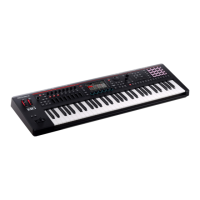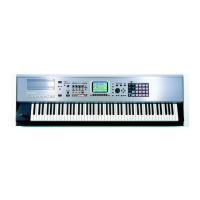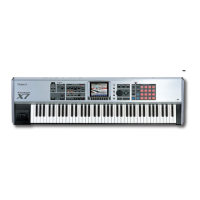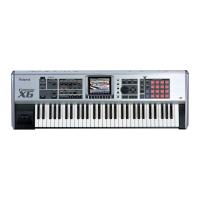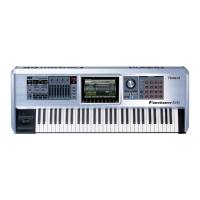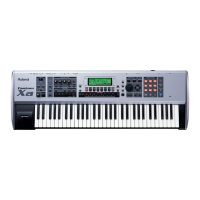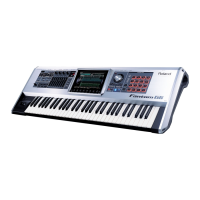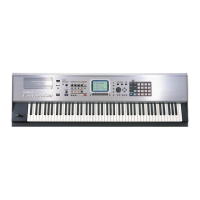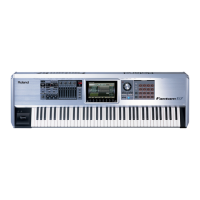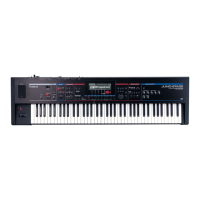Settings for the Entire FANTOM
165165
Setting the date and time
1. Move the cursor to the date and time elds at the
bottom of the screen.
2. Press the [ENTER] button.
The Time Stamp window appears.
3. Use the [E1]–[E5] knobs to specify the date and
time.
4. Select [E6] CLOSE.
5. Save the system settings, and then turn the power
o and on again.
Keyboard Settings
(KEYBOARD)
Parameter Value Explanation
Keyboard
Velocity
Species the velocity transmitted when a key is played.
REAL
The transmitted velocity value will
correspond to the force with which
you strike the key.
1–127
The transmitted velocity value will
be xed, regardless of the force with
which you strike the key.
Keyboard
Velocity Curve
LIGHT
The keyboard will have a lighterfeeling
touch. Since you’ll be able to reach
fortissimo () without having to play
as strongly as with the “MEDIUM”
setting, the keyboard will feel lighter.
This setting makes it easier for people
with reduced nger strength to play
the keyboard.
MEDIUM
This is the standard keyboard touch
setting.
HEAVY
The key will have a heavier-feeling
touch. Since you’ll need to play more
strongly than with the “MEDIUM”
setting in order to reach fortissimo
(), the keyboard will feel heavier. This
setting allows you to use your playing
dynamics to add more expression to
your performances.
Keyboard
Velocity Curve
Oset
-10–+9
Adjusts the keyboard velocity curve.
Lower values make the keyboard feel
lighter.
Higher values make the keyboard feel
heavier.
Arpeggio
Arpeggio
Trigger
Quantize
Species how arpeggios will be triggered.
OFF
The arpeggio starts the moment you
play the keyboard.
BEAT
If you play the keyboard while the
sequencer or a rhythm pattern is
playing, the arpeggio automatically
starts at the beginning of the beat.
MEAS
If you play the keyboard while the
sequencer or a rhythm pattern is
playing, the arpeggio automatically
starts at the beginning of the measure.
Arpeggio
Switch Mode
OFF/ON
The ARPEGGIO screen does not appear
when you operate the [ARPEGGIO]
button to change from OFF to ON.
OFF/ON & ARP
SCREEN
The ARPEGGIO screen appears when
you operate the [ARPEGGIO] button to
change from OFF to ON.
Parameter Value Explanation
Chord
Memory
Switch Mode
OFF/ON
The CHORD MEMORY screen does not
appear when you operate the [CHORD
MEMORY] button to change from OFF
to ON.
OFF/ON &
CHD SCREEN
The CHORD MEMORY screen appears
when you operate the [CHORD
MEMORY] button to change from OFF
to ON.
Pedal Settings
(PEDAL)
Parameter Value Explanation
Pedal Assign
Source
SYS, SCENE
Species whether the functions
controlled by pedals connected to the
PEDAL CTRL 1, 2 jack are determined
by the system settings (SYS) or by the
settings of the scene (SCENE).
Control Pedal
Pedal1, 2
Polarity
STANDARD,
REVERSE
Selects the polarity of the pedal
connected to the PEDAL CTRL 1, 2
jacks.
Depending on the model of pedal, the
result of depressing or releasing the
pedal might be the opposite of what
you expect. If so, choose the “REVERSE”
setting. If you’re using a Roland pedal
(that has no polarity switch), choose
the “STANDARD” setting.
Pedal1, 2
Assign
Specify the functions that are controlled by pedals
connected to the PEDAL CTRL 1, 2 jacks.
OFF No function is assigned.
CC01–31,
33–95
Controller number 1–31, 33–95
BEND DOWN
The same eect as moving the pitch
bend lever to the left.
BEND UP
The same eect as moving the pitch
bend lever to the right.
AFT Aftertouch
START/STOP Start/stop the sequencer.
TAP TEMPO
The same eect as pressing the panel
[TAP] button.
SCENE DOWN
Switch the scene to the previous
number. When using a scene chain,
switch to the previous number in the
chain set.
SCENE UP
Switch the scene to the next number.
When using a scene chain, switch to
the next number in the chain set.
OCT DOWN
The same eect as pressing the panel
OCTAVE [DOWN] button.
OCT UP
The same eect as pressing the panel
OCTAVE [UP] button.
ARPEGGIO SW
The same eect as pressing the panel
[ARPEGGIO] button.
CHORD MEM
SW
The same eect as pressing the panel
[CHORD MEMORY] button.
DEC
The same eect as pressing the panel
[DEC] button.
INC
The same eect as pressing the panel
[INC] button.
Pedal1, 2
Range Min
0–127
Specify the lower limit value for the
range of the assigned function.
Pedal1, 2
Range Max
0–127
Specify the upper limit value for the
range of the assigned function.

